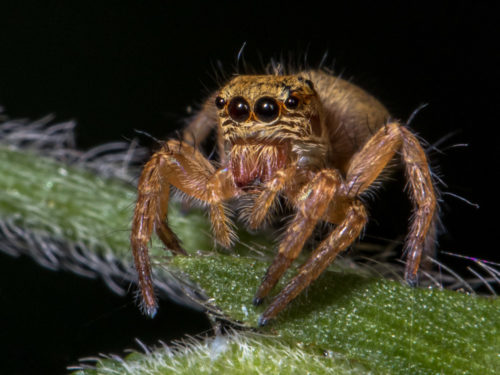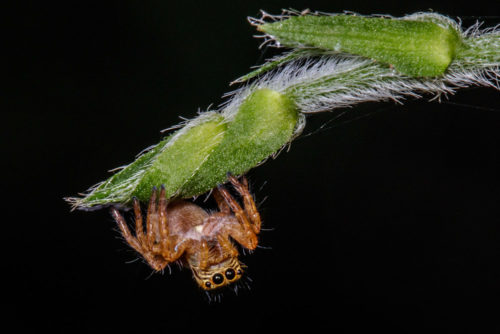
The common name for salticids is jumping spiders and many are indeed phenomenal leapers. However, jumping alone is not what distinguishes salticids from other spiders. What makes salticids special is their unique, complex eyes and acute eyesight, not leaping prowess. Salticids have large anterior medial eyes that give them an almost catlike appearance. No other spider has eyes like these and no other spider has such intricate vision-guided behaviour. A better common name for salticids would probably be Eight-legged cats ?

Jumping spiders have excellent vision, with among the highest acuities in invertebrates. Spider eyes differ from insect eyes. While insects have compound eyes, spiders possess simple eyes. They have one lens per eye which is made of a thin layer of the cuticle. They direct light to the retina which is the light-detecting cells. Jumping spiders have a problem–how do they focus their eye as their lens is solid and they don’t have iris as humans do.

If you can’t move your eyes, move your head instead. You can see the spider carefully tilting its head to get a better look at you. It’s those adorable head tilts that make photos of jumping spiders so very cute. This tilt can only give you a rough focus. For fine focus, more is needed. The evolutionary workaround for a jumping spider is to have eyes that are a bit of a tube.

There’s a second lens at the end of the tube, and unlike the outer lens, it’s flexible. Basically, jumping spiders have built themselves two little telescopes. By adjusting the angle and shape of the inner lens, the spiders can focus and zoom in on what they are looking at.
The retina at the end of the eye has multiple layers of cells, each specialized in a different type of vision. By angling each of their eye-tubes just so, the spiders have a binocular vision with excellent acuity and full-colour perception.

Because the retina is the darkest part of the eye and it moves around, you can sometimes look into the eye of a jumping spider and see it changing colour. When it is darkest, you know the spider is looking straight at you, because then you are looking down into its retina.

The eight eyes are grouped four on the face (the two big Anterior Median eyes in the middle, and two smaller Anterior Lateral eyes to the side), and four on top of the carapace (two medium-sized eyes toward the back, and two very small eyes in front of them).

You can think of the Anterior Median eyes (AME) as acting like our fovea, with high acuity but a small field of view, and the remaining six eyes acting like our peripheral vision, with lower resolution but a broad field of view. The secondary eyes on the side of their heads give them more or less 360° vision.

Jumping spiders don’t spin elaborate webs and wait for prey; they actively hunt during the day. They mostly use their silk as a belaying line while they leap and climb after their prey. Jumpers also sometimes have bright colours and elaborate dancing displays for mating.

Do spiders see what we humans do? How spider brains interpret the information captured by their eyes we can only speculate.
Read more about jumping spider eyes, including some cool equations in these two lovely papers which I have used to write this article.


ಪ್ರಕೃತಿಯ ಇಂಥ ಕುಸುರಿ ಕೆಲಸಗಳನ್ನೆಲ್ಲ ಕಾಣುವುದಿರಲಿ ಕಲ್ಪಿಸದೆಯೂ ಅವು ಹೊಸೆದು ಎಳೆಯುವ ಜೀವಜಾಲದ ಅಸಂಖ್ಯ ಎಳೆಗಳನ್ನು ಅಧ್ಯಯನ ಮಾಡುವುದಿರಲಿ ಉಂಟೆಂದು ಗ್ರಹಿಸದೆಯೂ ಸಾವಿರದೆಂಟು ‘ಪೋಷಕ’, ‘ನಾಶಕ’ಗಳನ್ನು ಎರಚಾಡುತ್ತೇವಲ್ಲಾ, ನೇರ ಮನುಷ್ಯ ಉಪಭೋಗಕ್ಕೆ (ಯೋಗ ಅಲ್ಲ) ಒದಗದವನ್ನೆಲ್ಲ ಕಸವೆಂದು ದೂಡುತ್ತೇವಲ್ಲಾ….
This is amazing! I love the nature and everything about it. We have so much awesome animals on this planet. This is just mind blowing! Keep up the good work. Love your photography!
Very cool post. Love learning more about this tiny jumpers. Also, so cool to see they have been compared to my other favourite animals which are cats